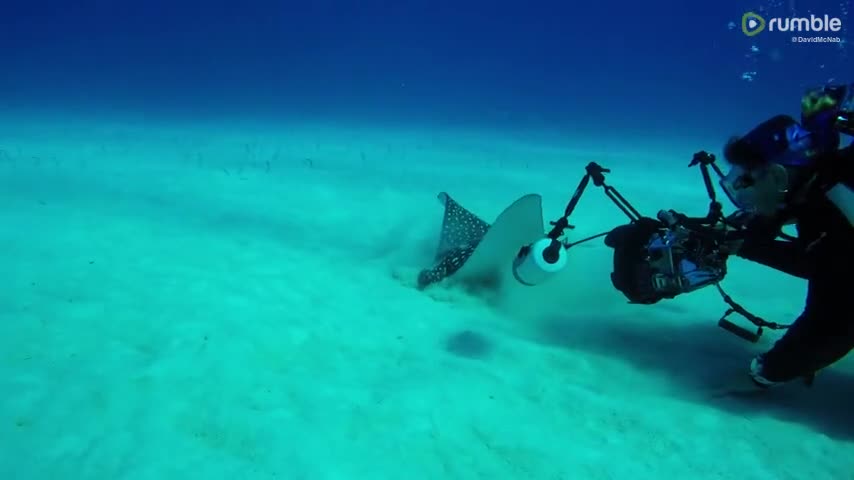Premium Only Content

Huge spotted eagle stingray allows photographer to capture stunning close ups
Huge spotted eagle stingray allows photographer to capture stunning close ups
Spotted eagle rays are a rare treat for scuba divers to witness in the ocean. They are graceful and majestic, beautiful and mysterious. To see one from afar is something that happens infrequently. But to be able to venture close enough to touch one is an unforgettable experience.
This large spotted eagle ray was digging in the sand for mollusks that make up a large part of its diet. They eat clams, conchs, small fish and even crustaceans that are often burrowed into the sand. The way they find their prey is a wonder of nature. Special organs in their flat wings are able to detect the minute electrical impulses of tiny creatures buried beneath. The rays dig using their snout and inhale sand, expelling it through their gills. This allows them to find and eat the creatures in the sand. They also beat their wings to push sand away from their food in order to make it easier to uncover.
Like all stingrays, these eagle rays have poisonous spines in their tails that they can use for defense if threatened. Even large creatures such as sharks are wary of a fully grown eagle ray. The rays are preyed upon by large tiger sharks, hammerhead sharks, and silvertip reef sharks. Growing as large as nine to ten feet across and weighing up to 225kg (almost 500lbs), a large ray is both quick enough and formidable enough to fend off all but the most determined shark. Despite this ability to deliver a painful and dangerous tail strike, the eagle ray is not harmful to humans and will usually shy away from people. Occasionally, eagle rays are curious about humans and will sometimes swim alongside a scuba diver for a brief look. Highly intelligent, they are capable of displaying a keen interest in a human who does not pose a threat.
This scuba diver made a slow and respectful approach and was rewarded with some very rare footage of an eagle ray eating right in front of her camera. The ray was undisturbed, and possibly even curious about her as she captured her shots and footage.
-
 13:22
13:22
Stephen Gardner
2 hours ago🔥You'll NEVER Believe what Trump wants NOW!!
14.2K44 -
 54:56
54:56
Digital Social Hour
1 day ago $1.04 earnedDOGE, Deep State, Drones & Charlie Kirk | Donald Trump Jr.
5.07K -
 DVR
DVR
The Trish Regan Show
3 hours agoTrump‘s FCC Targets Disney CEO Bob Iger Over ABC News Alleged Misconduct
15.7K15 -
 1:48:19
1:48:19
The Quartering
4 hours agoElon Calls White People Dumb, Vivek Calls American's Lazy & Why Modern Christmas Movies Suck!
85.3K44 -
 2:08:42
2:08:42
The Dilley Show
5 hours ago $25.74 earnedH1B Visa Debate, Culture and More! w/Author Brenden Dilley 12/26/2024
74.8K21 -
 4:55:59
4:55:59
LumpyPotatoX2
7 hours agoThirsty Thursday on BOX Day - #RumbleGaming
63.9K5 -
 1:04:52
1:04:52
Geeks + Gamers
6 hours agoDisney RATIO'D on Christmas Day | Mufasa Embarrassed By Sonic 3
50.4K4 -
 8:27:46
8:27:46
Sm0k3m
10 hours agoPlaying games on Rumble
30.6K2 -
 10:37
10:37
Russell Brand
2 days agoHow is this even allowed?
178K845 -
 1:37:26
1:37:26
Real Coffee With Scott Adams
7 hours agoEpisode 2701 CWSA 12/26/24
96.7K89